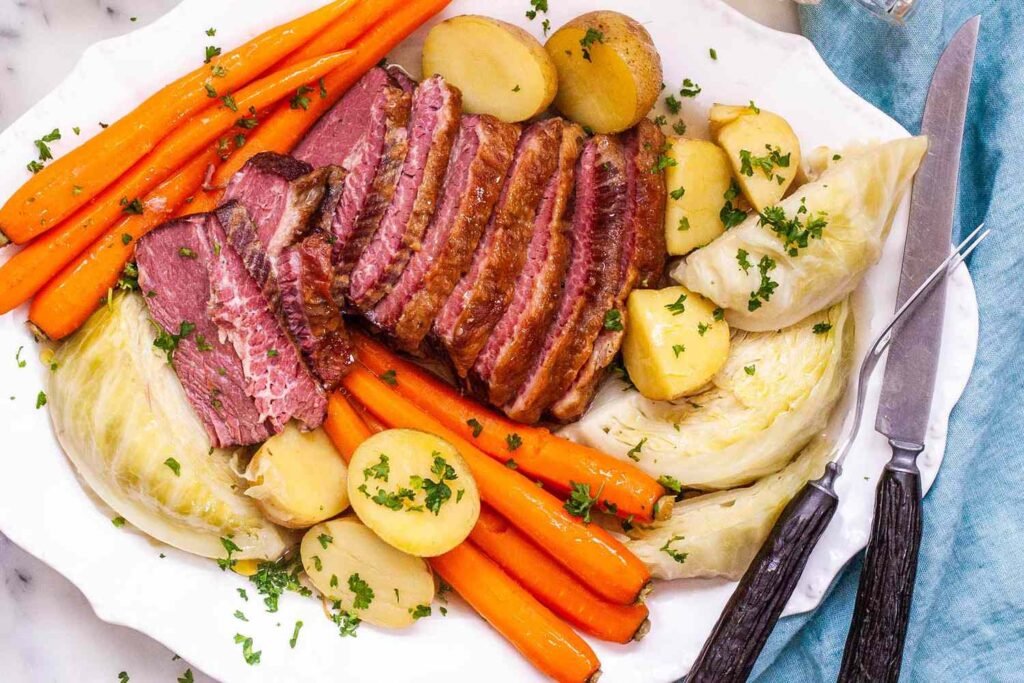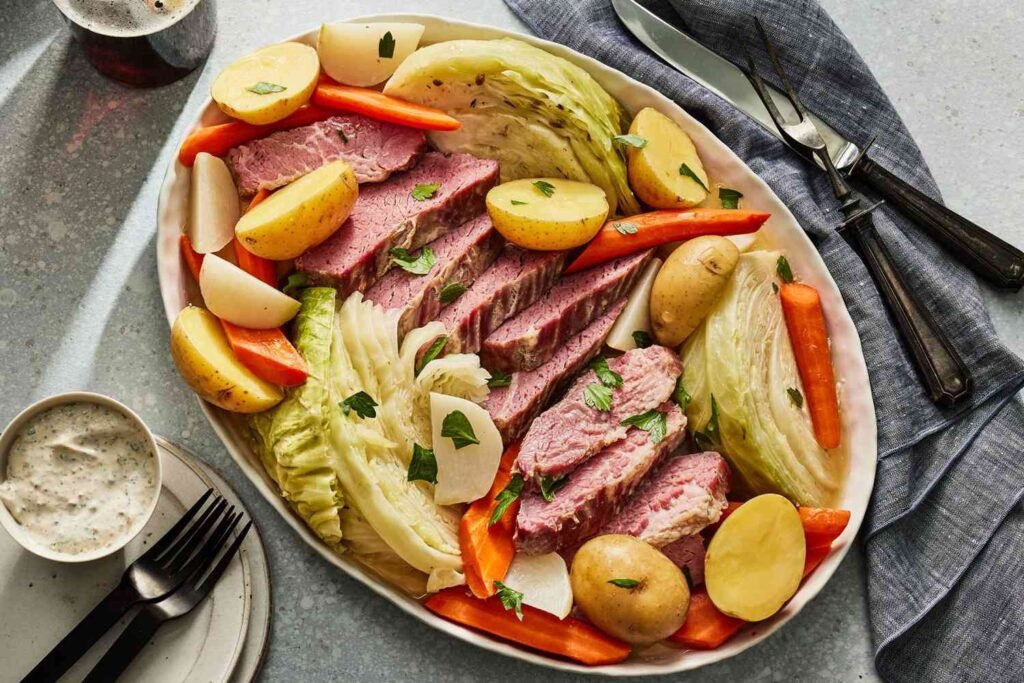Corned Beef and Cabbage Recipe
Corned beef and cabbage – a dish synonymous with St. Patrick’s Day celebrations and hearty comfort food. But this delectable combination boasts a rich history that goes beyond its festive association. Let’s embark on a journey to explore the origins of this culinary duo, delve into a simple yet flavorful recipe, and discover some expert tips for making the perfect corned beef and cabbage.
From Salted Necessity to Irish-American Favorite
Before refrigeration became commonplace, salt played a crucial role in preserving meat. Corned beef, specifically, is brisket (the lower breast cut) cured in a brine solution with pickling spices like coriander, cloves, and black peppercorns. This process not only enhanced flavor but also extended the shelf life of the meat.
While corned beef has roots in Europe, its pairing with cabbage is a distinctly American invention. Traditionally, Irish cuisine featured bacon alongside cabbage. However, 19th-century Irish immigrants in New York City found themselves living in close proximity to Jewish delis. The corned beef offered at these establishments bore a striking resemblance, in terms of flavor profile, to the bacon they were accustomed to back home. Thus, the iconic corned beef and cabbage was born, forever changing the culinary landscape of America.
The Simplicity of a Perfect Dish
The beauty of corned beef and cabbage lies in its deceptive simplicity. The recipe requires minimal prep work and readily available ingredients, making it a fantastic choice for weeknight dinners or weekend feasts.
Here’s a breakdown of what you’ll need and how to put it all together:
Ingredients:
- 1 (3-pound) corned beef brisket (with spice packet)
- 10 small red potatoes
- 5 medium carrots
- 1 large head of cabbage

Instructions:
- Prep Time: Gather all your ingredients and ensure the corned beef has thawed completely.
- Simmering the Corned Beef: Place the corned beef brisket in a Dutch oven and cover it with water. Add the included spice packet, bring the mixture to a boil, and then reduce the heat. Let the corned beef simmer for approximately 2 hours, or until it reaches a near fork-tender consistency.
- Veggie Prep: While the corned beef simmers, put your vegetable prep skills to work. Cut the potatoes in half, peel and cut the carrots into 3-inch pieces, and section the cabbage into wedges.
- Introducing the Vegetables: After the 2-hour simmering period for the corned beef, add the potatoes and carrots to the Dutch oven. Let them cook for roughly 10 minutes, or until the vegetables are almost tender and the meat is fully fork-tender.
- Cabbage Time: Finally, incorporate the chopped cabbage and cook it for an additional 15 minutes, or until tender-crisp.
- Resting and Slicing: Remove the corned beef from the Dutch oven and allow it to rest for 15 minutes. This resting period allows the juices to redistribute throughout the meat, resulting in a more flavorful and tender final product. While the meat rests, keep the broth and vegetables simmering in the Dutch oven.
- Serving Up Perfection: Slice the corned beef against the grain (perpendicular to the muscle fibers) for optimal tenderness. Plate the sliced corned beef alongside the cooked vegetables and ladle some of the flavorful broth over the top.
Tips for Taking Your Corned Beef and Cabbage to the Next Level
While the basic recipe delivers a delicious outcome, you can always add your own personal touch to elevate the dish even further. Here are a few ideas:
- Spice it Up: For a touch of heat, incorporate some chopped fresh jalapenos or red pepper flakes along with the vegetables.
- Herb Heaven: Fresh herbs like thyme, bay leaves, or parsley can add another layer of flavor during the simmering process.
- Guinness Glory: If you’re feeling adventurous, consider replacing some of the water with a can of Guinness beer for the initial simmer. The dark beer imparts a rich, malty flavor to the corned beef and vegetables.
- Mustard Mania: No corned beef and cabbage experience is complete without a dollop of your favorite mustard or horseradish for dipping.
- Leftover Magic: Don’t toss leftover corned beef and cabbage! Reheat it gently and use it in creative ways. Think Reuben sandwiches, corned beef hash, or even delicious pot pie fillings.

Beyond the Plate: The Enduring Legacy of Corned Beef and Cabbage
Corned beef and cabbage has transcended its role as a mere dish. It’s a symbol of cultural exchange, a testament to immigrant ingenuity, and a cornerstone of festive celebrations. The next time you savor this delicious combination, take a moment to appreciate its rich history and the unique circumstances that led to its creation.
Variations on a Classic: A Global Exploration
While the Irish-American version reigns supreme, corned beef and cabbage isn’t a monolithic dish. Here’s a glimpse into some interesting international variations:
- Irish Bacon and Cabbage: The original pairing, featuring bacon (usually unsmoked) instead of corned beef.
- Brazilian Pastrami na Brasa: Corned beef (or pastrami) grilled over charcoal, often served with farofa (toasted cassava flour) and vinaigrette.
- Czech Zelí s Uzeným Masen: Cabbage cooked with smoked meat (not necessarily brisket) and dumplings.
- Reuben’s Delight: A North American twist – corned beef, sauerkraut, Swiss cheese, and Russian dressing piled high on rye bread.

A Final Note: A Celebration of Comfort and Culture
Corned beef and cabbage is a dish that warms the soul and satisfies the taste buds. It’s a testament to the enduring power of tradition and the creativity that emerges from cultural exchange. So, the next time you gather around the table to enjoy this classic dish.
Nutrition Facts (per serving)
| 882 | Calories |
| 42g | Fat |
| 50g | Carbs |
| 71g | Protein |
| Nutrition Facts | |
|---|---|
| Servings Per Recipe 6 | |
| Calories 882 | |
| % Daily Value * | |
| Total Fat 42g | 54% |
| Saturated Fat 17g | 83% |
| Cholesterol 240mg | 80% |
| Sodium 165mg | 7% |
| Total Carbohydrate 50g | 18% |
| Dietary Fiber 6g | 21% |
| Total Sugars 6g | |
| Protein 71g | 143% |
| Vitamin C 40mg | 44% |
| Calcium 83mg | 6% |
| Iron 7mg | 41% |
| Potassium 1937mg | 41% |
* Percent Daily Values are based on a 2,000 calorie diet. Your daily values may be higher or lower depending on your calorie needs.
** Nutrient information is not available for all ingredients. Amount is based on available nutrient data.
(-) Information is not currently available for this nutrient. If you are following a medically restrictive diet, please consult your doctor or registered dietitian before preparing this recipe for personal consumption.
Powered by the ESHA Research Database © 2018, ESHA Research, Inc. All Rights Reserved

